1964 Chrysler New Yorker: Exner’s Last Stand
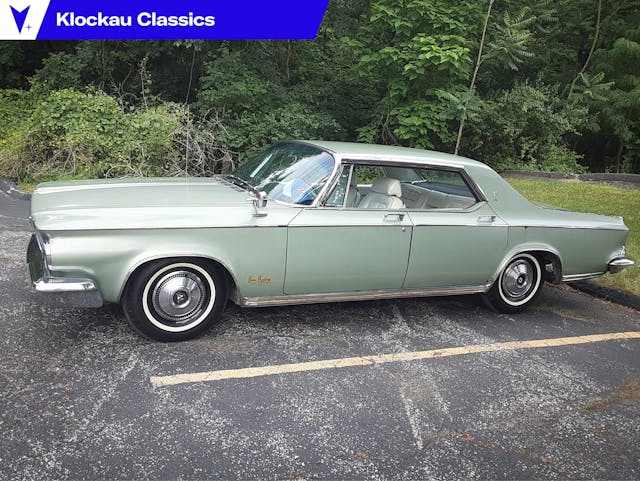
You never know what you’re going to run across. Or what you’re going to write about next, if you happen to write about old cars. I certainly never know. Some cars I’ll see, gawk at, and write about that very same day. Others I will immediately love and just know I’m going to write a column on, then I get distracted and it gets pushed onto the back burner, sometimes sitting for months. Or years.
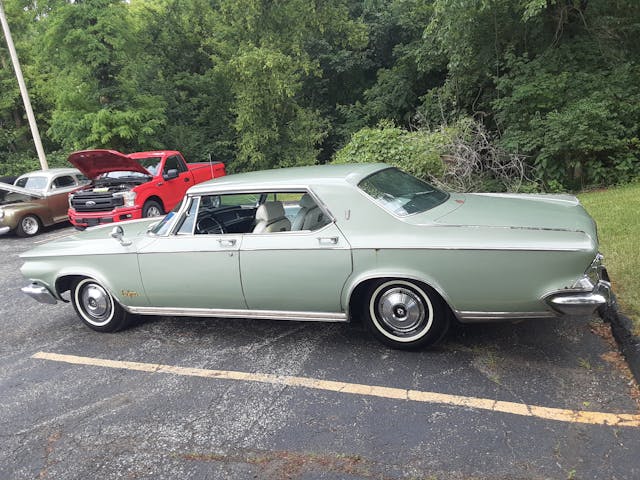
Today’s featured car is the former. I saw it at a show on a Tuesday evening in mid-June and began writing it up on Thursday that same week. Some cars just have that effect on me. In this case, it was a car I always liked but never saw many of: 1963–64 Chryslers.
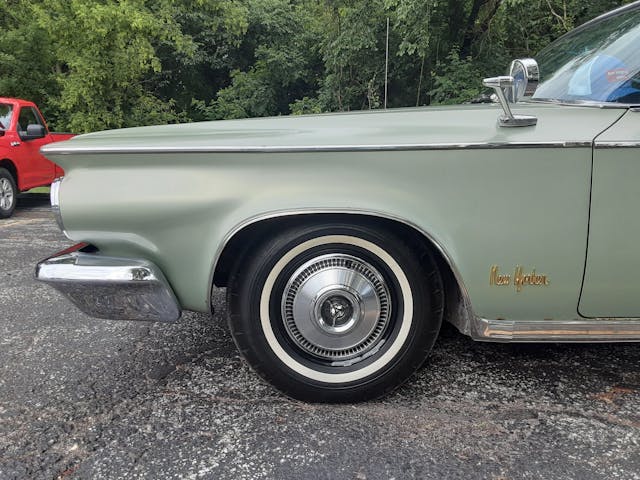
Chryslers morphed frequently between 1950 and ’65. First, you had the rather tall and narrow, rather plain 1949–52 models, designed so you wouldn’t knock your hat off when you got into or out of the car. Then the “Hundred Million Dollar Look” 1955–56s, which cranked style up to 11. Followed almost immediately by the giant-finned “Forward Look” 1957–59s.

The 1960s were all new but still sported huge fins. However, in 1962, the exact same car as the 1961 appeared in showrooms, its fins were shorn. A shock to many, but these “plucked chickens” set the stage for 1963.
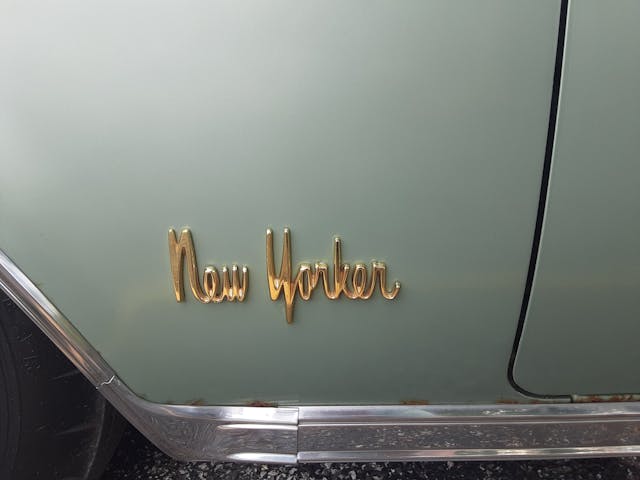
Chrysler Corporation’s style chief at the time was Virgil Exner, and after the giant fin era ended, his new styling direction was predicted in the all-new compact 1960 Valiant. Lots of different surfacing designs and planed areas on the sheetmetal. It continued with the full-size 1962 Dodges and Plymouths, which were downsized a good decade and a half before the 1977 Chevrolet Caprice.

Starting in 1963, Chryslers got yet another restyling, though from the cowl and windshield it appeared that large parts of the 1960 body were still present beneath the sheetmetal. A 1963 300 in blue with white interior paced the Indianapolis 500 that year.
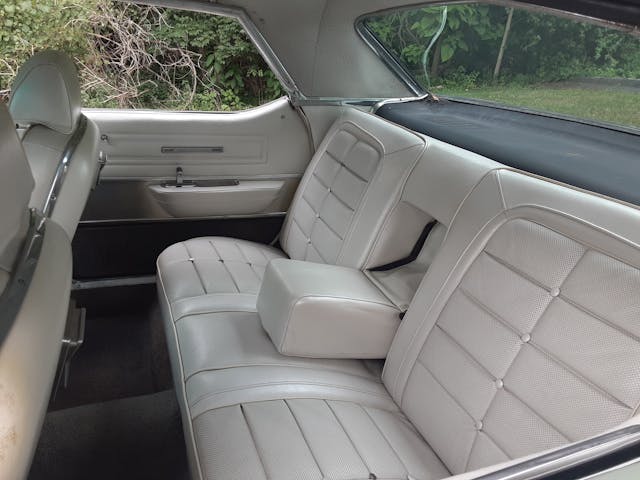
While not a carbon copy of the 1960 Valiant or 1962 Plymouths and Dodges, the themes were somewhat similar, if less wild. I liked the styling myself, but I never had much opportunity to admire any in person, because I just never saw these. How many have I seen over the years? Five, counting today’s 1964 New Yorker.

First up was a legitimate 300K, seemingly abandoned, probably about a dozen years ago. It has since disappeared—hopefully restored!
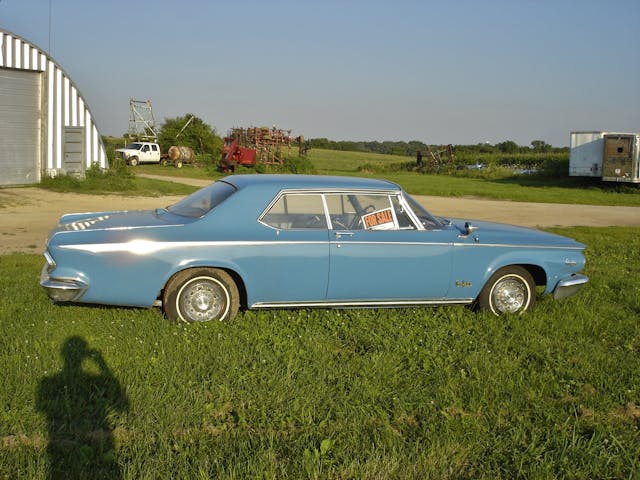
Next up was a ’64 Newport that was sort of a “bitsa” with ’68 Plymouth wheel covers and New Yorker script on the fenders. I also saw a ’64 Newport sedan in Iowa City some time ago that was a bit weathered but pretty well preserved; it was a similar green to today’s car, but I’m not 100 percent sure it was the same color. And that’s it. And I go to a LOT of car shows.

The 1963 Chryslers carried on in four series: Newport, 300 Sport, New Yorker, and 300J. The latter model was, of course, the “banker’s hot rod” hi-test model, available only as a two-door hardtop. A five-year, 50K warranty on the powertrain was an added enticement to folks nervous about reliability after the 1957 quality control fiasco.
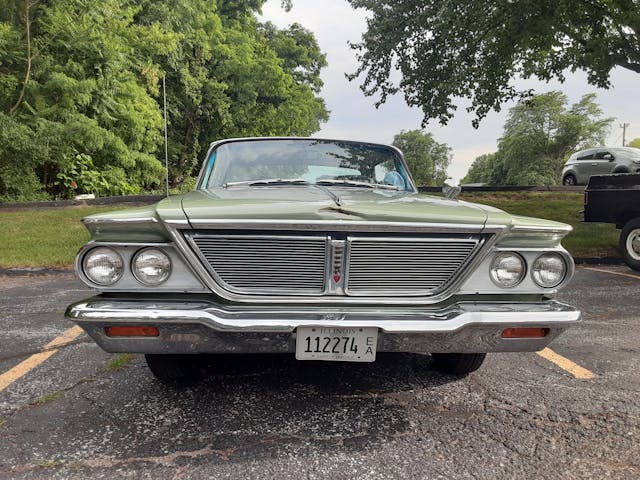
A total of 118,800 ’63 Chryslers were built for the year. Unsurprisingly, the 300J was the rarest, with 400 units.

For 1964, only minor styling revisions were made—the most noticeable change being the deeply tunneled quad headlights of the prior year being enclosed in a trapezoidal, chrome-edged trim panel. The round dual taillights of ’63 got a similar treatment, with more squared-off units to match the revised front end.
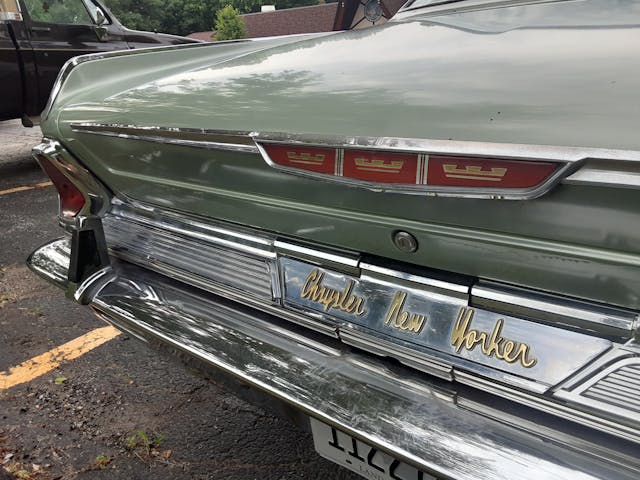
These cars have a lot of differing styles. It’s a ’60s shape, but it has a lot of ’50s style gingerbread. My friend Mike Batch Kirouac, a dedicated Mopar man with several Newports, New Yorkers, and Windsors of his own, reminded me: “Virgil Exner’s last design for Chrysler. He still had one foot in the excess of the 1950s.”

It’s apparent on these cars, especially on the New Yorkers, which naturally had more chrome trim, scripts, and styling fillips than the Newports. The trim was more noticeable compared to ’63 New Yorkers, especially the fatter side rocker trim molding.
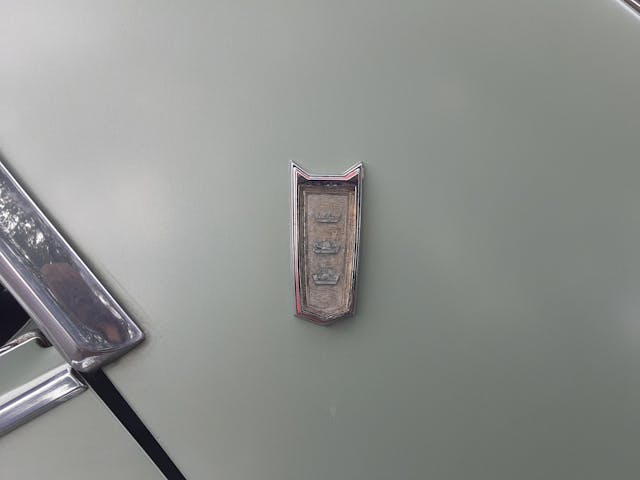
Our featured car, one of 10,887 New Yorker four-door hardtops built in 1964, was finished in Pine Mist with a white interior. I spotted it at the monthly cruise night at the Viking Club of Moline, Illinois. I had heard of these show nights for a couple of years, but for one reason or another had never made it out to one.
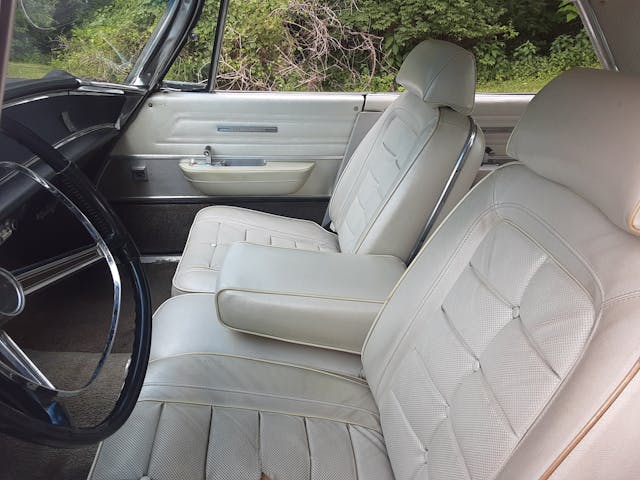
Isn’t it funny how you can drive past a place weekly, for decades, and never set foot on the property? In my case, the last time I’d been at the Viking Club was, believe it or not, in 1998 when my friends Judy and Allen Noftsker got married. The ceremony had been at a church, but the reception was held here. And although my memory was a tad hazy, the place looked more or less the same as it had 25 years ago!
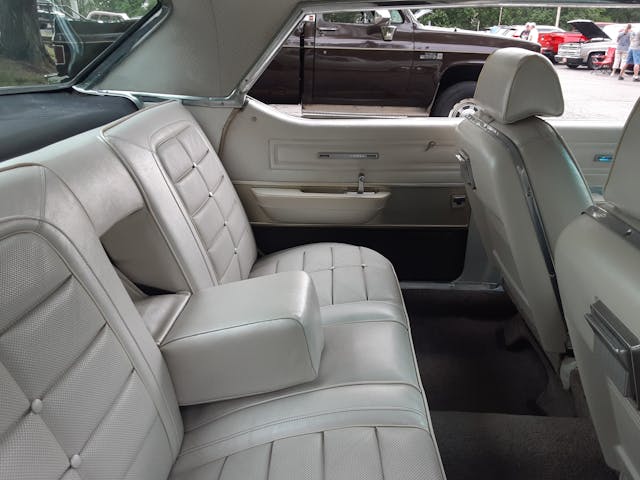
I parked, and it appeared to be a nice show. I started walking around, taking pictures here and there, when I came to the last car in the first row, and there sat this New Yorker. Holy cow! I immediately began taking many more pictures than were strictly necessary.
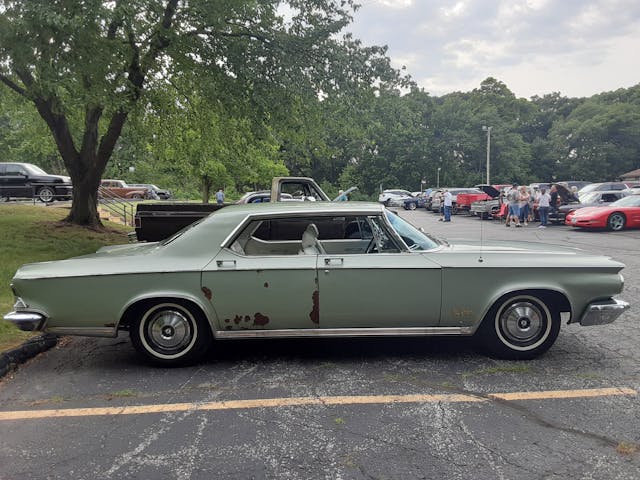
It was weathered but seemingly fairly well preserved, nonetheless. I loved the silver-green paint combined with the white interior, black carpet, and black instrument panel.
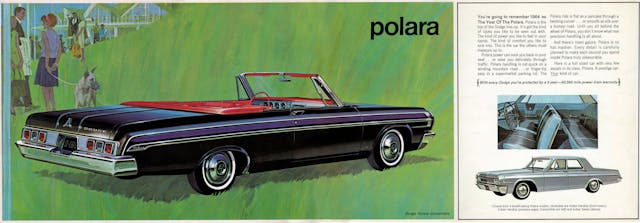
And while at the time I wasn’t totally certain, I was pretty sure those weren’t the factory wheel covers. I had guessed ’65 Dodge Coronet. But while researching for this article I found I was close, but wrong: They’re from a ’64 Dodge Polara.

Above are what the factory-correct 1964 New Yorker wheel covers would look like, by the way. And while I’m digressing, I really love that Town and Country wagon!
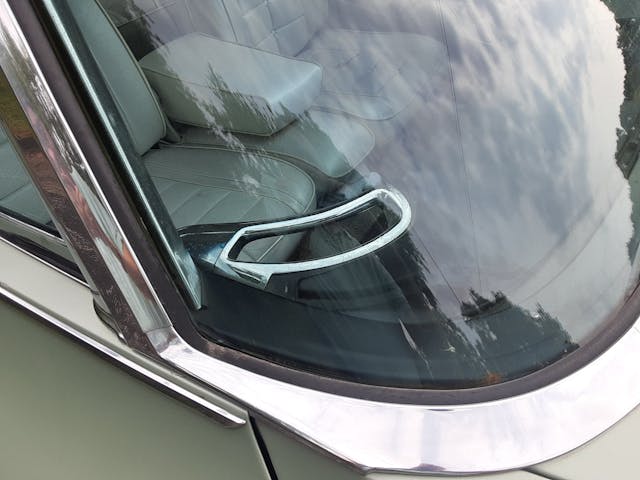
One neat feature I noticed belatedly was the passenger grab handle. While walking around the car (probably on photo #28 by that time), I noticed this chrome fillip.
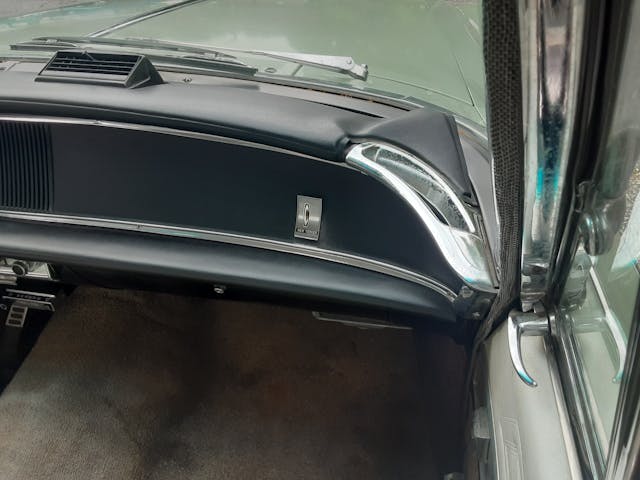
I walked back, peeked in the passenger side window, and saw this very sleek-looking grab handle. So cool! Actually, I love the entire instrument panel on these. As I told a friend of mine, Robert Reed (who owns the ’78 LeSabre Custom coupe I wrote about previously), it reminds me of the dash on a ’60s Chris-Craft or Century Coronado. By the way, this was also the last year for Chrysler’s push-button transmission, sadly. It would be floor shift or column shift only starting in 1965.

That year, Elwood Engel would replace the recently-departed Virgil Exner, and Chryslers would become very rectangular, and sleek. Long, low, and wide, with fender skirts.
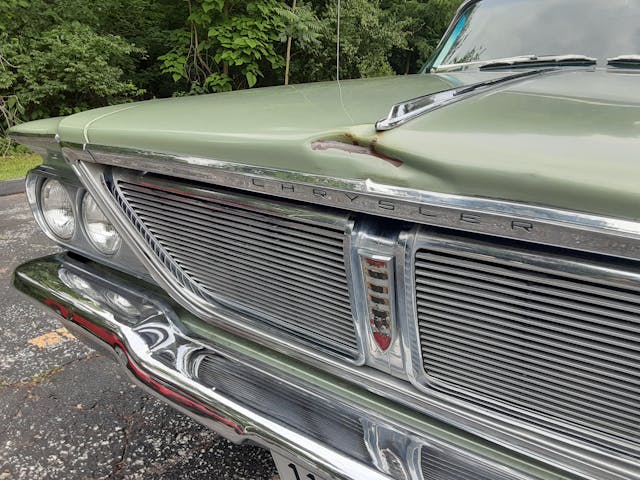
I love those cars too, but they were a totally different kind of Chrysler from the 1963–64s. Seeing this car made my day! It’s one of the things I love about car shows and why I go to so many. You never know what you’re going to find.

***
Check out the Hagerty Media homepage so you don’t miss a single story, or better yet, bookmark it. To get our best stories delivered right to your inbox, subscribe to our newsletters.


As a teenager with a paper route in a big city, there was a Chrysler Plymouth dealer on my paper route. Twas the early to late 60s and all those big Chrysler, Plymouth and Imperial gems were on that lot new and used. Usually they were unlocked so at 6:30 am after passing out 100+ newspapers I would sit in the cars and admire them. Dad bought a used 60 Chrysler Windsor from that dealer. Wow that 383 with four barrel and TorqueFlite was fast! Soon the fins were old news as the 63s came along. My elderly customers loved the flat sided 65-68 Chryslers. Stainless steel fender edges set off the big colorful sheet metal. Lovely variety and quick year upon year evolution. My classmate’s mom bought a new Chrysler in 67 and I bought her 1955 Plymouth V8 with PowerFlite and power steering. And I still have 55 Plymouth just for the fun of it. Good engineering back then but prone to rust.
It was summer 1965 and we had just moved to So. Cal from Michigan driving cross country in a 1959 Plymouth Fury station wagon, 3 kids and mom and dad….no AC but the back window rolled down, sucking in fumes and dust of every type; what a trip! My 4th grade memory recalled it was terribly hot crossing the plaines and even hotter when arriving. Mom’s tolerance ended somewhere in Arizona and it was only a short time in CA before we acquired a sparkling white 1963 Chrysler 300 sport, with factory air. Red vinyl interior with fold down armrests. The push button shifter, big V-8 and all the other options made this a car to be cared for and noticed. It had belonged to an older lady who bought a new Chrysler every other year and had less than 10,000. Fantastic car as a daily driver and several long west coast cruises. I learned to drive and parallel park in the beast. It was the primary vehicle for 10 years and then passed to my brother for another 10. He kept it beautiful but while it was still a head turner it got whacked by a pickup in WY and it was too much for a roving bachelor to repair. Damn that was a great car!
Wow! Thanks so much for this 1964 Chrysler New Yorker review. These cars are a very major part of my childhood, I seemed to be surrounded by them. Our family was a Mopar family ever since the 1930s when my family lived in East Detroit and my mom’s side of the family all worked at Chrysler’s Highland Park headquarters location. By the early 60s, we had moved to Southern California. My dad had a 63 Newport 4 door hardtop, it was white with blue vinyl interior. It was a great car, our first car with factory installed air conditioning. The air vents on the dash were different than every other car. I liked how they came up out of the dash and resembled household a/c units. Another unique feature only ever found in a Chrysler product was the rounded rectangleur shaped steering wheel, I read its design was to enable a better view of the instrument cluster. And the push button drive automatic transmission control were at the far left side on the dash. I loved the sound the buttons made when depressed. I was really sorry to see them discontinued in the 65 model year. I actually learned to drive in that 63. It had a 361 cid, and a 2 barrel Carter carburetor. I also liked how the steering wheel felt when it returned to center after making a turn. Our next door neighbor had a 63, 300. It was the same colors as ours, but it was a 2 door hardtop, and being a 300, it came with the 383 cid engine. And my uncle had a 64 300, it was light blue with blue vinyl interior, it too was a 2 door hardtop, and it also came with the 383 under the hood. I really liked the sculptured look of the 63,64 Chryslers. Their styling was different than anything at GM or Ford. Unlike your limited experience with these Chryslers, they were very popular here in Southern California, I remember seeing them in all the models and colors, including station wagons and convertibles. They were bigger than the downsized 62 model year, but they didn’t look as big as the full-size GM and Fords. From what I can remember, the 3 that I mentioned above were all very reliable and very well liked. When the 65s were released, they were a lot bigger and formal looking, a trend that continued throughout the 60s and 70s. Every generation was very different than the last, and I liked them all. From Forward Look fins to the fuelsage styling introduced in 69. Chrysler styling may not have been for everyone, but I like them all. And how can we talk about the 60s Chryslers without mentioning the famous sound of the Chrysler starters? Thanks again for the memories of these very important Chryslers that were part of my childhood. I loved looking at the pictures of these timeless Chryslers.
My parents had a 1963 New Yorker that also had an impact on my youthful years. It was ivory with a red interior and a 413 engine and a/c. It was primarily my mom’s car as my dad had a company car. They bought it used in 1970 to replace a rusty 1957 Oldsmobile Fiesta wagon. It looked nice and even when ours was purchased the styling didn’t appear dated. I got to practice driving and eventually took my driving test in it. The examiner couldn’t figure out how the seat belt latched. The instrument panel was arranged nicely. The steering wheel and push button selector didn’t seem odd at all since I had driven few cars for comparison. Cleaning all that interior chrome, aluminum and stainless took quite awhile. I won many bets that friends couldn’t change the radio station, the acceleration was strong enough to pull back an outstretched arm and that grab handle was proven to be useful. The drawback was fuel consumption, and that’s when regular was 35¢ per gallon. Reliability was excellent except that the power window motors would break their mounts if you slammed the doors too hard. Then I also discovered the joys of junkyards.
One last point, in the movie the Fugitive (1993), there’s a great scene of a 1964 Chrysler 300, parked on the street in front of an apartment in Chicago. It’s black, and it seems to be a prominent feature in the scene. In my opinion, it makes the scene. Check it out.
The Parish priest had a 63 4 dr ht black
A great article about a great car. I really like cars like this, original and unrestored, sure it has some cosmetic warts but it’s also almost 60 years old, I’d drive it with pride and enjoy it…
I appreciate 4 doors, and these are a cool car with some odd execution –which I like.
That blue 2-door though is very sharp from the side profile. The rear roofline is looking ahead (like Buick Riviera) compared to most early 60s cars.
Uncle Don had a bably blue 63 Newport with blackwalls, Uncle Leonard then got a 64 Newport same color as your New Yorker in the article. Then Uncle Donny (different uncle) topped them all with a beige 65 New Yorker–with air conditioning! First car with air a then 8 year old ever rode in. My dad was just going from Chevy to Buick as we got our first 63 three-holer that took us on route 66 from WI to Phoenix for Xmas 65. What a trip!!! Loved uncles Chryslers–and the funky steering wheel. My wife grew up with a 65 300 coupe her dad was a Mopar guy too-
It sounds like we came from very similar families, that all drove Chryslers. That makes us lucky in my book. Every summer my parents and my uncle Bob would spend two weeks up at Mammoth Lakes in the High Sierras. I always thought it was cool to see those two Chryslers on highway US 395. It was a 5 to 6 hour drive at the time, just two lanes most of the way. We were always very comfortable as we crossed the Mojave desert with our windows rolled up and the air conditioning on. Those Chryslers were iconic in the 60s as they are today.
Hmmmmmmm. Ehhhhh….hmmmmmmm. I like the advertising artwork better than the real McCoy. These cars just never appealed to me. Those “Forward Look” years though – gorgeous.
We had the ’64 wagon for less than a year when I was growing up. My dad ordered it with the big engine so he could tow a trailer with it. The garage door would not shut with the car inside, it was too long!
After chrome falling off, and a rear end noise at 10K miles, my dad got rid of it. Back to GM vehicles after that.
That design shows a lot more Elwood Engel influence than it does Virgil Exner’s – the slab sides, squared profile, and minimal detailing are not Exner hallmarks. Engel’s work after taking the reins from Exner – which is a story in itself – started showing up on the ’63 Chrysler products.
Wrong. The 1963 Chrysler full size cars were 100% Exner. There is an Exner signed drawing of his proposal for the next Imperial. The drawing was dated 1961. Done well in advance of him being replaced by Engel. Search Exner Imperial drawing 1961. The 1963 full size Chryslers were a scramble in 1961-62. Elwood Engel was busy with the redesign of the Imperial in 1961, while Exner was being made the fall guy for the sales disaster of the 1961 models (which had been on sake since late 1960. So with Engel bust re-doing the Imperial (which wouldn’t launch until late 63), the race to find a solution for a 1963 full size had to be done fast. So they dug through their pile of Exner files, and decided that his old Imperial downsizing drawing would be an easy fit on the plucked chicken full size models. And if you look closely, they grabbed the dash out of a 1955-56 Desoto too. The only part that Engel might have played was signing a form that punted approvals up to the executivesame for final. But he probably didn’t even have that much to do with it. Chrysler was in big trouble, and cobbling together the 63 and 64 Chrysler stop gap cars before the pure Engel 65 C-body was ready, was pretty clever. So have a look at the Exner Imperial idea drawing. It is a perfect match to the 1963 Chrysler. The re-addition of tiny fins and diamond tail lights in 1964 was probably a junior employee idea, and probably was signed off by Engel. But the 63, with the sloped trunk and no fins and round tail lights is 100% Exner. And as you will see, the the whole car was literally designed from an older Exner drawing.
I couldn’t agree more with your observations that these were a rare bird. I had a black ’64 Saratoga coupe with the same interior and it was a great car. Then, this past weekend, I was at a car show in Taber Alberta, Canada and saw a perfect 1963 Chrysler New Yorker wagon! It was a dark blue survivor in amazing condition in and out and was a real treat to see. Like you said, you never what you’re going to see at a car show, especially an all marks show and shine, and that’s what keeps me coming back.
Now that’s a big boat.
My father was a Chrysler man and I was fortunate enough to inherit his ’55 New Yorker and then his ’63 New Yorker. Both were 4 door piller sedans – the ’55 a light blue with darker blue stripe and the ’63 all black. Both were great vehicles – trouble free, cushy ride, lots of power and very “convenient” in my dating years. I have many fond memories of both and would love to have another of either (both?!) as a weekend cruiser! Thanks for the flashback!
Family friends bought a 1964 Chrysler, new, from the dealer. After driving it for some time, they noticed that it rode “funny”, particularly under braking. They took it back to the dealer three times and were assured each time that everything was correct. They finally demanded an inspection by a factory representative at the dealership which showed there was no shock absorber on the right rear wheel because the mount had not been installed. The problem was corrected, but the dealership subsequently failed.
I loved these cars back then. My dad had a ’63 Dodge Dart GT, the styling was familial, to say the least. I liked that the big Dodges and even bigger Chryslers looked like our diminutive Dart!